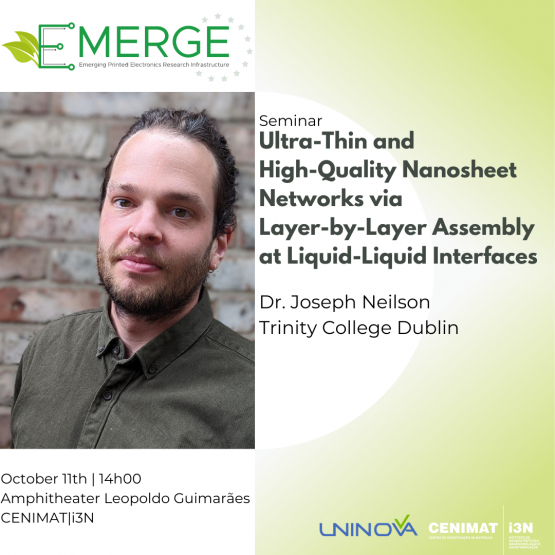
On Friday, 11th October, 14h00, at CENIMAT |i3N Amphitheater Leopoldo Guimarães, we will have the pleasure to listen to Dr. Joseph Neilson from Trinity College Dublin, talking about "Ultra-Thin and High-Quality Nanosheet Networks via Layer-by-Layer Assembly at Liquid-Liquid Interfaces". Joe is currently visiting CENIMAT within the EMERGE project. Click to read the abstract.
Make sure to be present!
Abstract: Solution-processable 2D materials are promising candidates for a range of printed electronics applications. Yet maximising their potential requires solution-phase processing of nanosheets into high-quality networks with carrier mobility (μNet) as close as possible to that of individual nanosheets (μNS). In practise, the presence of inter-nanosheet junctions generally limits electronic conduction, such that the ratio of junction resistance (RJ) to nanosheet resistance (RNS), determines the network mobility via . Hence, achieving RJ/RNS<1 is a crucial step for implementation of 2D materials in printed electronics applications. In this work, we utilise an advanced liquid-interface deposition process to maximise nanosheet alignment and network uniformity, thus reducing RJ. We demonstrate the approach using graphene and MoS2 as model materials, achieving low RJ/RNS values of 0.5 and 0.2, respectively. The resultant graphene networks show a high conductivity of σNet = 5 ×104 S/m while our semiconducting MoS2 networks demonstrate record mobility of μNet = 30 cm2/Vs, both at extremely low network thickness (tNet <10 nm). Finally, we show that the deposition process is compatible with non-layered quasi-2D materials such as silver nanosheets (AgNS), achieving network conductivity close to bulk silver for networks <100 nm thick. We believe this work is the first to report nanosheet networks with RJ/RNS<1 and serves to guide future work in 2D materials-based printed electronics.
